George Stackhouse Woolman (1846-1923)
by Brian Stevenson
last updated April, 2021
Between 1876 and 1894, G.S. Woolman's New York City shop was a major supplier of microscopes and other scientific and engineering equipment. Contemporary sources indicate that Woolman distributed his products throughout the U.S.A. Microscopes, slides, and other apparatus from Woolman are often seen in collections (Figures 1 and 2).
All of the items that Woolman retailed were brought in from outside manufacturers. He was trained in business, rather than manufacturing technologies. Prior to opening his own shop in 1876, Woolman had worked as a bookkeeper and manager for J.W. Queen & Company, first at their home site in Philadelphia, then from 1871 onward in their New York branch. He remained an agent for Queen, as well as other manufacturers. In 1894, Woolman sold his business back to Queen, while staying on as manager until 1898.
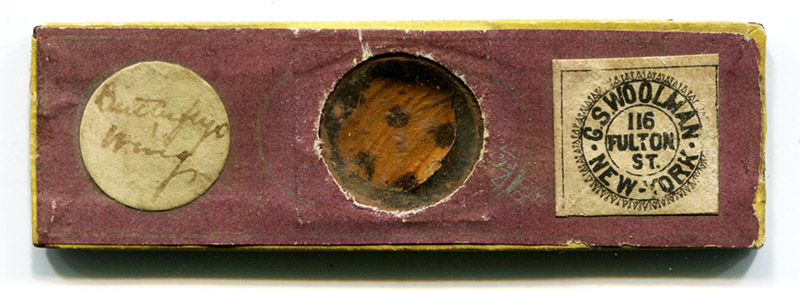
Figure 1A.
A "continental"-sized microscope slide that was retailed by G.S. Woolman. The pattern of the covering paper indicates that this slide was prepared by William H. Walmsley, who was an owner of J.W. Queen & Company from 1870 until 1877, and afterwards operated his own scientific instrument business in Philadelphia. Woolman did not produce any of the items that he sold.
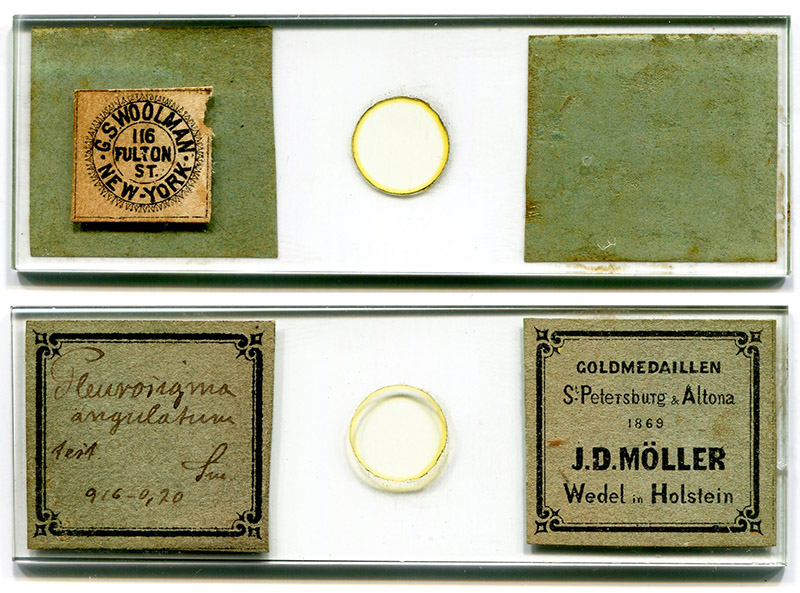
Figure 1B.
A standard-sized (1 x 3 inch) microscope slide, prepared by Johann Diedrich Möller, and retailed by G.S. Woolman.
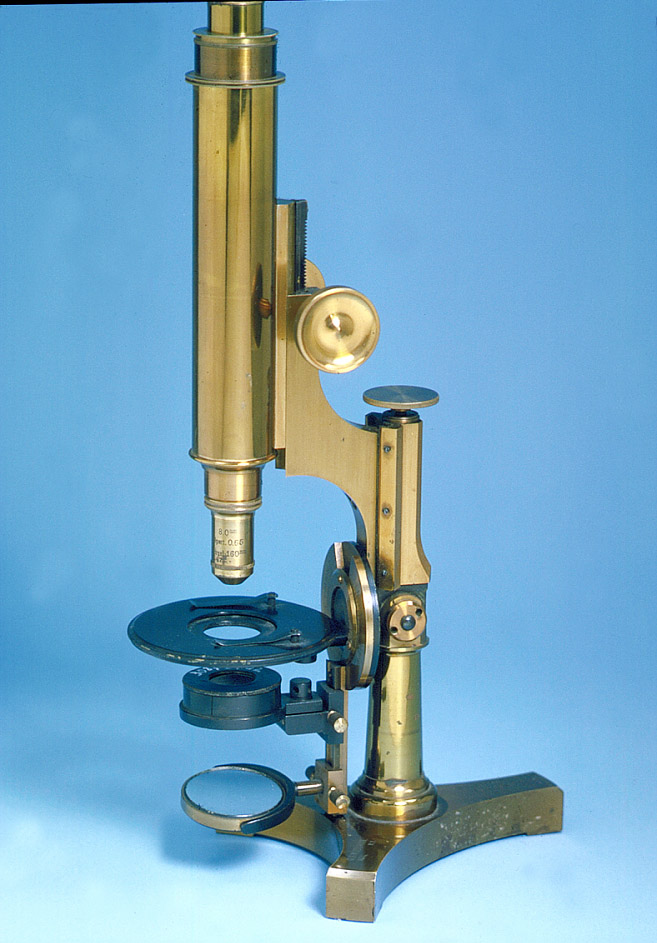
Figure 2.
A microscope that was sold by G.S. Woolman, inscribed “John W. Sidle & Co. Lancaster, Pa. Acme, 176” and “G.S. Woolman / Agt. N.Y.”. Sidle partnered with James L. Poalk in 1879 to manufacture "Acme" brand microscopes, then Poalk left in 1880 while Sidle continued as "Sidle & Co." In 1881, J.W. Queen & Company became the sole distributor for Sidle's microscopes, and soon afterward absorbed Sidle's business and manufactured "Acme" microscopes themselves in their Philadelphia factory. As an agent of Queen, Woolman had license to distribute Sidle and Queen instruments. Image adapted for nonprofit, educational purposes from https://americanhistory.si.edu/collections/search/object/nmah_1348372 .
George S. Woolman was born on August 14, 1846, in Blockley, Pennsylvania, at the time a township on the outskirts of Philadelphia. He was the sixth of eight children of Nathan and Sarah Ann (née Newbold) Woolman. Nathan operated a dairy production and delivery business.
The 1870 national census recorded that 19 year-old George was then employed as a "book keeper". That same year, James Queen sold his Philadelphia scientific manufacturing and retail business to Jesse S. Cheyney, William H. Walmsley, and Samuel L. Fox, who styled their business as "J.W. Queen & Co." The 1871 Philadelphia City Directory listed Woolman as a clerk for Queen.
Upon formation of the J.W. Queen & Co. partnership, Jesse Cheyney moved to New York City and opened a branch store. George Woolman was sent to New York in 1871 to help with that operation.
Early in 1876, Cheyney departed from the J.W. Queen & Co. partnership, and opened a competing business. Woolman then bought the New York operation from Queen, and moved the shop from 601 Broadway to 116 Fulton Street. He remained at that site throughout his tenure as owner.
It is notable, from a business angle, that Queen referred to Woolman as their "former manager" in their announcements of the sale (Figure 3), since Cheyney, the actual manager, was now a competitor.
His position as a business owner gave Woolman the resources to start a family, marrying Effie Norcross on December 6, 1877. The couple had four children, as two sets of twins. One of the first set of twins died within a year of his birth, and the other twin died when only 12. The second set, both girls, lived to late in adulthood.
Woolman's 1879 microscope catalogue shows that he retailed instruments by Queen, Henry Crouch, R. & J. Beck, and "Acme" (Sidle and Poalk), as well as lenses by Crouch, Beck, and Charles Spencer (Figure 5).
The business was evidently a financial success from the start. By the time of the 1880 census, the Woolman's had moved their home across the Hudson River to East Orange, New Jersey.
The business owner was featured in the 1888 Illustrated New York: The Metropolis of To-Day, "G.S. Woolman, Mathematical, Optical, and Philosophical Instruments, Drawing Materials, etc., No. 116 Fulton Street - To those of our readers, whether dealers in or users of any kind of mathematical, optical, or philosophical instrument, in need of same, we would strongly recommend to place their orders with Mr. G.S. Woolman, whose resources, facilities, and experience are unrivalled in this difficult branch of trade. He is a native of Philadelphia, who became connected with the trade upward of twenty-five years ago, and who in 1870 permanently removed to New York. In 1876 he opened his present establishment, always permanently located at No. 116 Fulton Street, and which has become popularized and familiar throughout leading professional and trade circles, as a place where the best instruments and accessory apparatus can be purchased at the lowest prices. Mr. Woolman is both a direct importer and a heavy dealer in instruments of domestic manufacture, being the agent here for Messrs. James W. Queen & Co., of Philadelphia, Messrs. R. & J. Beck, of London, and Messrs. W. & L.E. Gurley, manufacturing opticians of this city. The stock carried by Mr. Woolman is the most comprehensive, elaborate, and reliable in town, and comprises full lines of mathematical instruments; telescopes, and microscopes of all standard powers; opera-glasses adapted to every want, and finished in all styles from plain leather to the most beautiful mother of pearl; spy glasses, marine glasses; spectacles and eye-glasses of every conceivable power, with the best pebble and other lenses, and adapted to the most exacting requirements. Surveyors’ instruments and equipments, from theodolites to staffs and chains, are a specialty, while all through the list the prices will be found the lowest quoted, both at wholesale and retail. Mr. Woolman's monogram is accepted as the best trade mark on all goods in his line, and as the result of his honorable, progressive, and liberal policy, he has acquired and permanently retains the patronage of leading surveyors, engineers, colleges, and seminaries of learning, specialists, and the public at large, and is a worthy representative of this important branch of trade".
Woolman was credited for introducing America to disposable paper wipes for cleaning lenses, as described by The American Monthly Microscopical Journal in 1892, "Paper for Cleaning the Lenses of Objectives and Oculars. - The so-called Japanese filter paper (the bibulous paper often used by dentists when filling teeth) is being used for cleaning the lenses of oculars and objectives. Whenever a piece is used once it is thrown away. It is more satisfactory than cloth or chamois, because dust and sand are not present, and from its bibulous character it is very efficient in removing liquid or semiliquid substances. Use it for removing immersion fluid from objectives, cloudiness or dirt from eye-pieces, glass slips, or thin glass. Water, glycerine, or other fluids can be removed. It is very cheap. It is put up in packages of 500 sheets, 10 x 7 inches, at $1.00, and 100 sheets, 10 x 7 inches, at 25c. It is for sale by nearly all dealers in microscopes and materials. G. S. Woolman, 116 Fulton st., New York, is the one who has introduced these cheap packages" (Figure 14).
In 1894, it was announced that, "For a long time Queen & Co. have felt the need of a New York office. They succeeded in purchasing the entire business of G.S. Woolman, so long in the scientific instrument business at 116 Fulton street, New York, and secured his services as their New York manager. The establishment of this New York branch will be a convenience to the many customers of Queen & Co. in that vicinity, and cannot fail to still further increase their business".
Woolman remained as manager of Queen's New York branch until 1898, when "Queen & Co., Inc., Philadelphia and New York, announces that Mr. G.S. Woolman has ceased to be the manager of its office in the latter city".
George, Effie, and their two surviving daughters moved back home to Philadelphia. Effie died there, on April 20, 1899.
The 1900 and 1910 censuses show that George Woolman operated a boarding house on Race Street, Philadelphia, assisted by his daughters and his unmarried elder sister, Martha Ann. In 1900, the Woolmans hosted 11 boarders and employed a cook, a waiter, and a chambermaid. By 1920, George, Martha Ann, and daughter Dorothy had moved to a smaller boarding house on Sellers Avenue, which Dorothy managed.
George S. Woolman died by drowning on July 20, 1923, shortly before his 77th birthday. His death certificate also noted that he had long suffered from epilepsy, so he may have died as a result of a seizure while bathing or swimming.

Figure 3.
Excerpt from Woolman's 1879 microscope catalogue, describing the 1876 transfer of ownership of Queen's New York branch to Woolman.
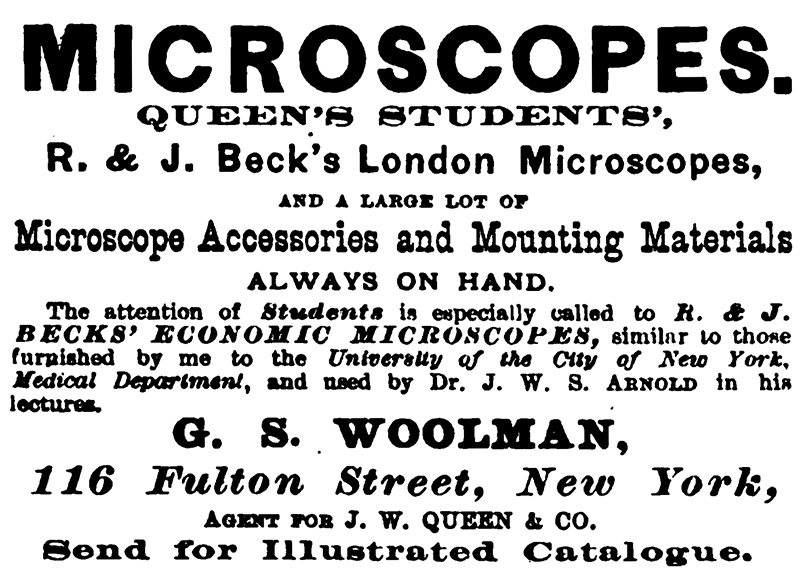
Figure 4.
An 1878 advertisement, from "The Medical Record".
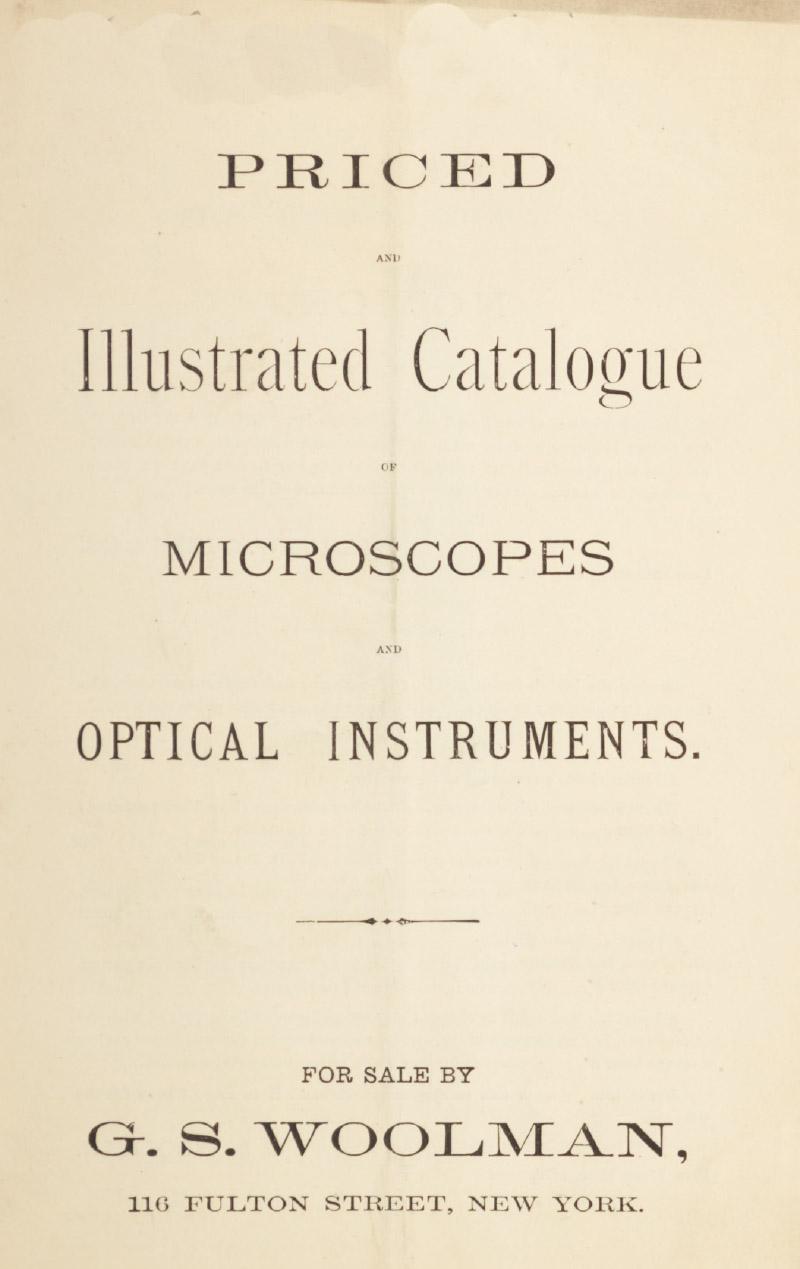
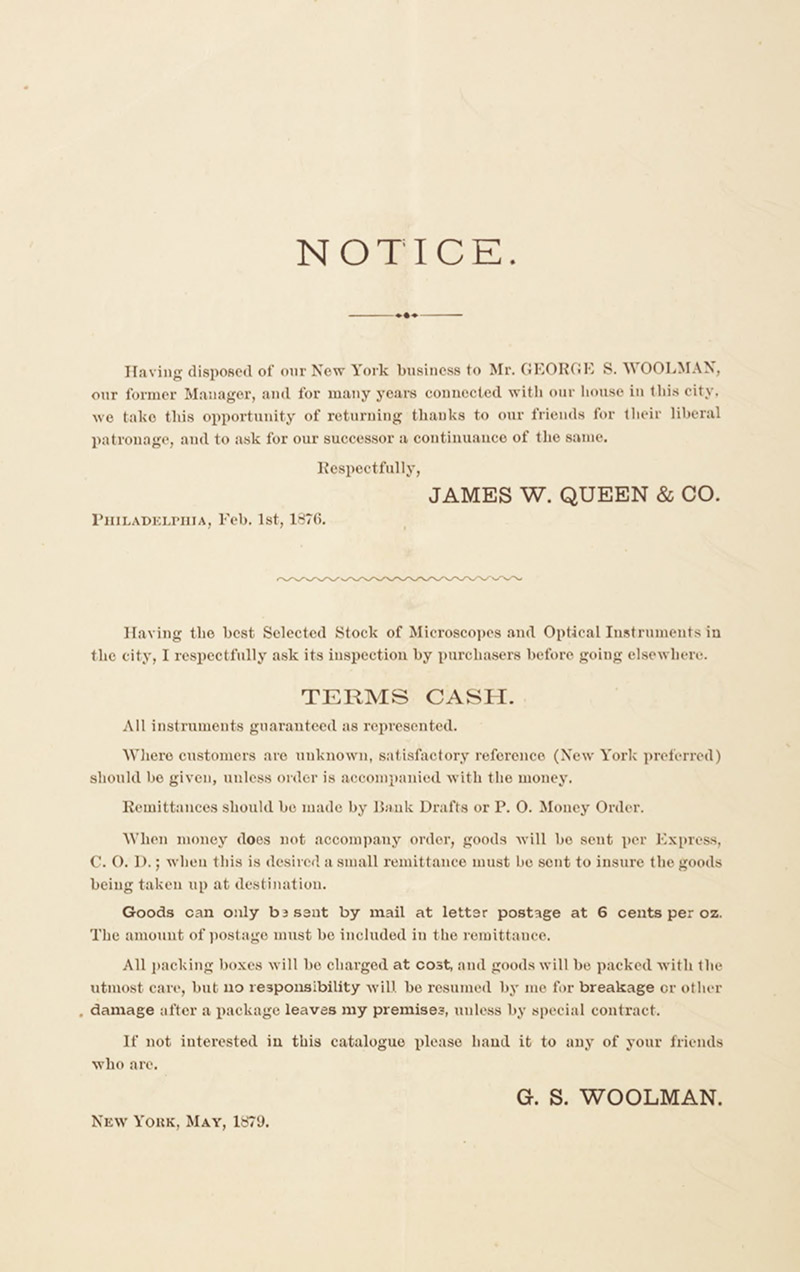
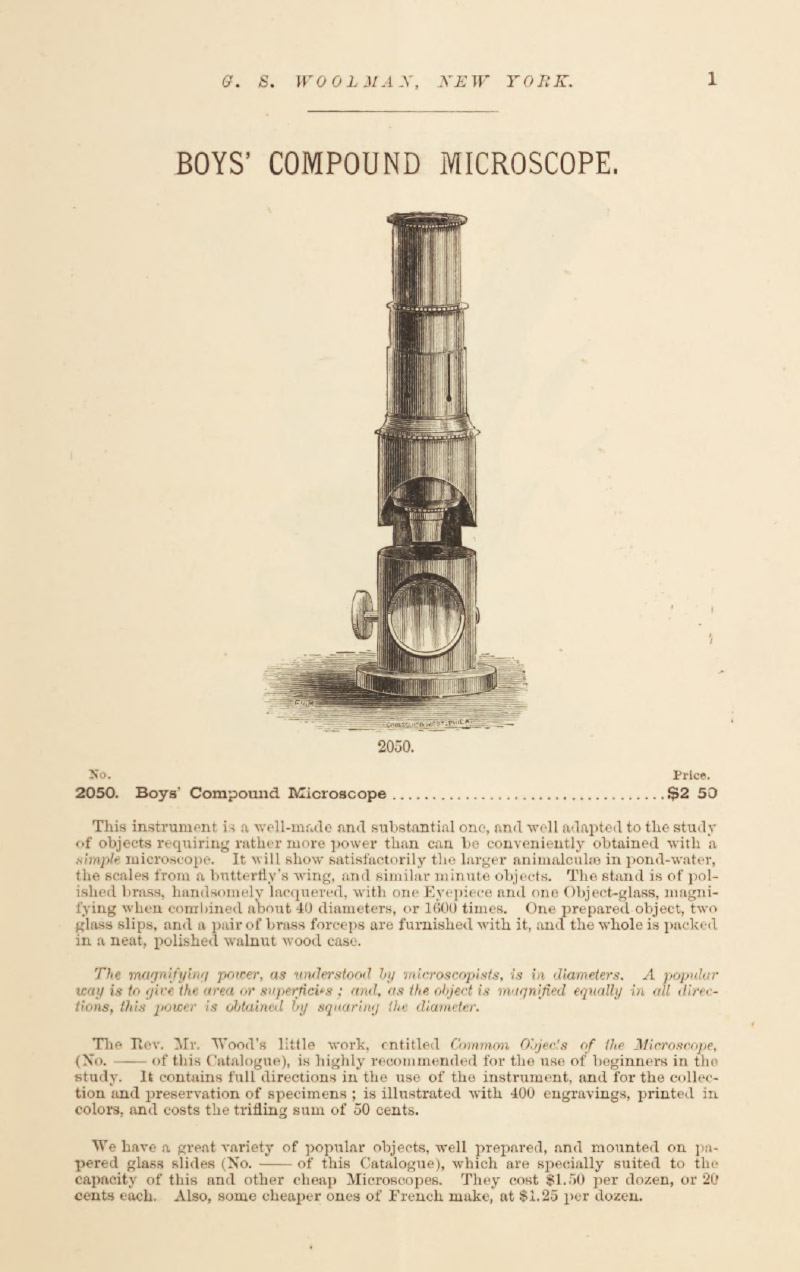
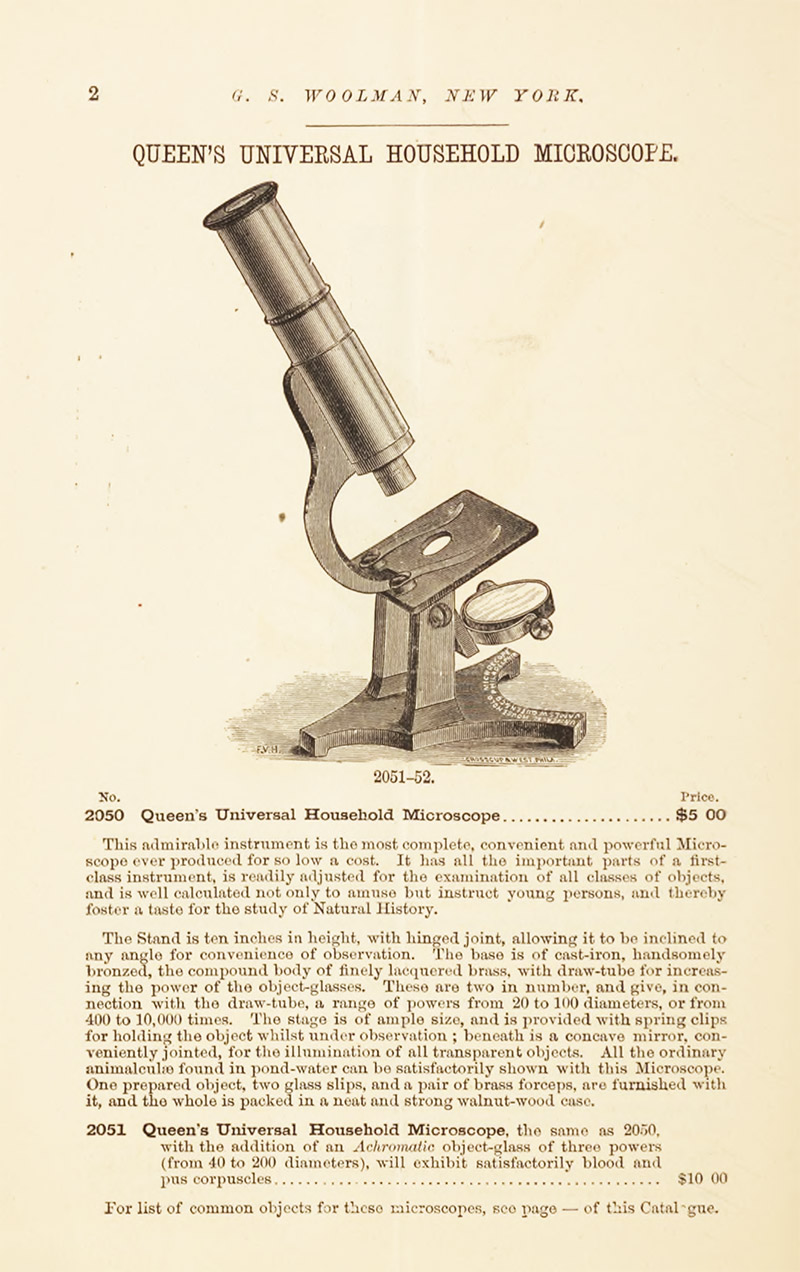
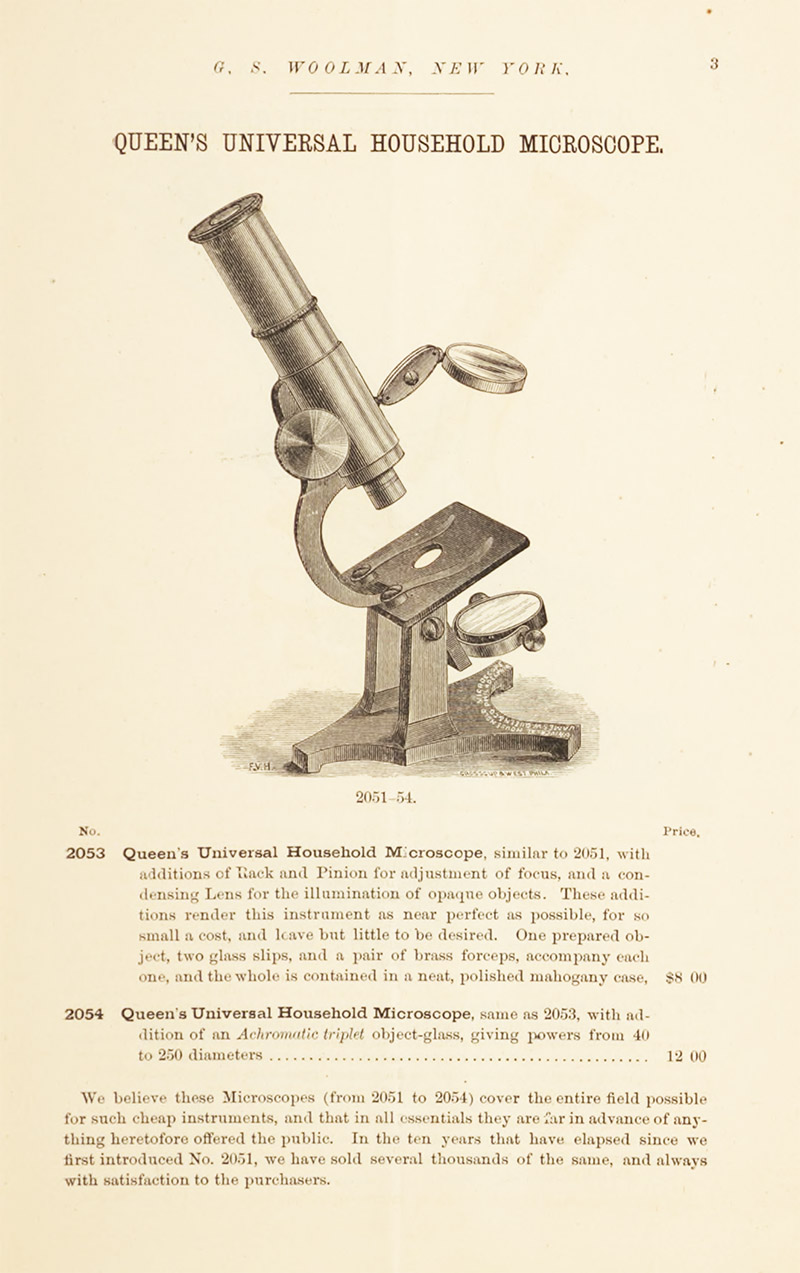
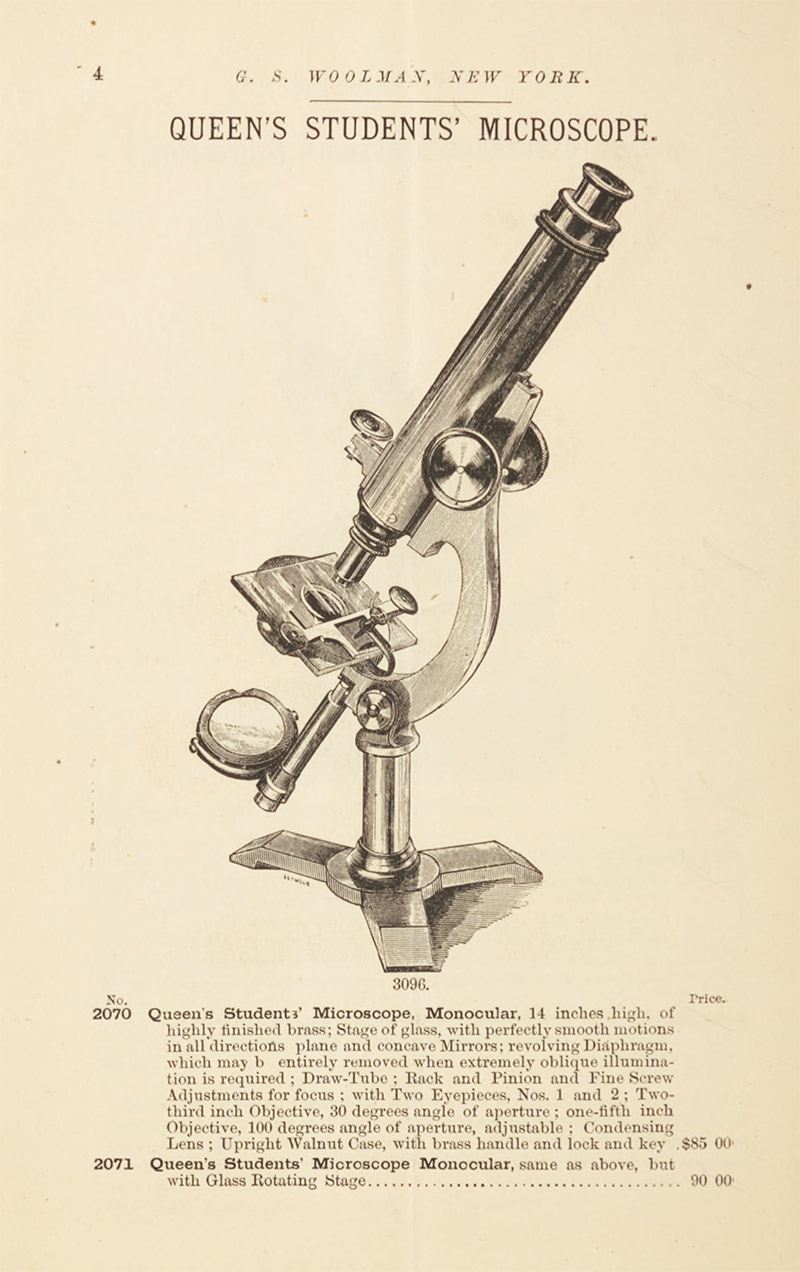
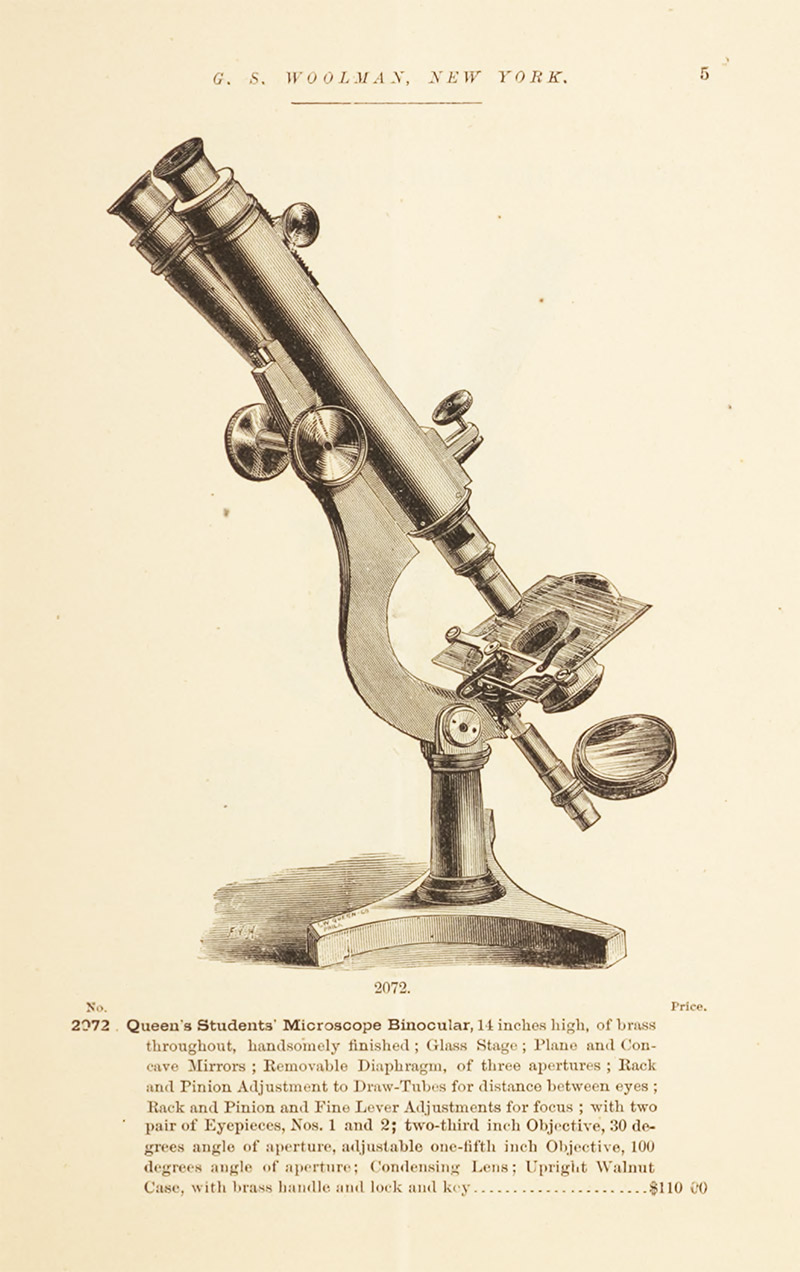

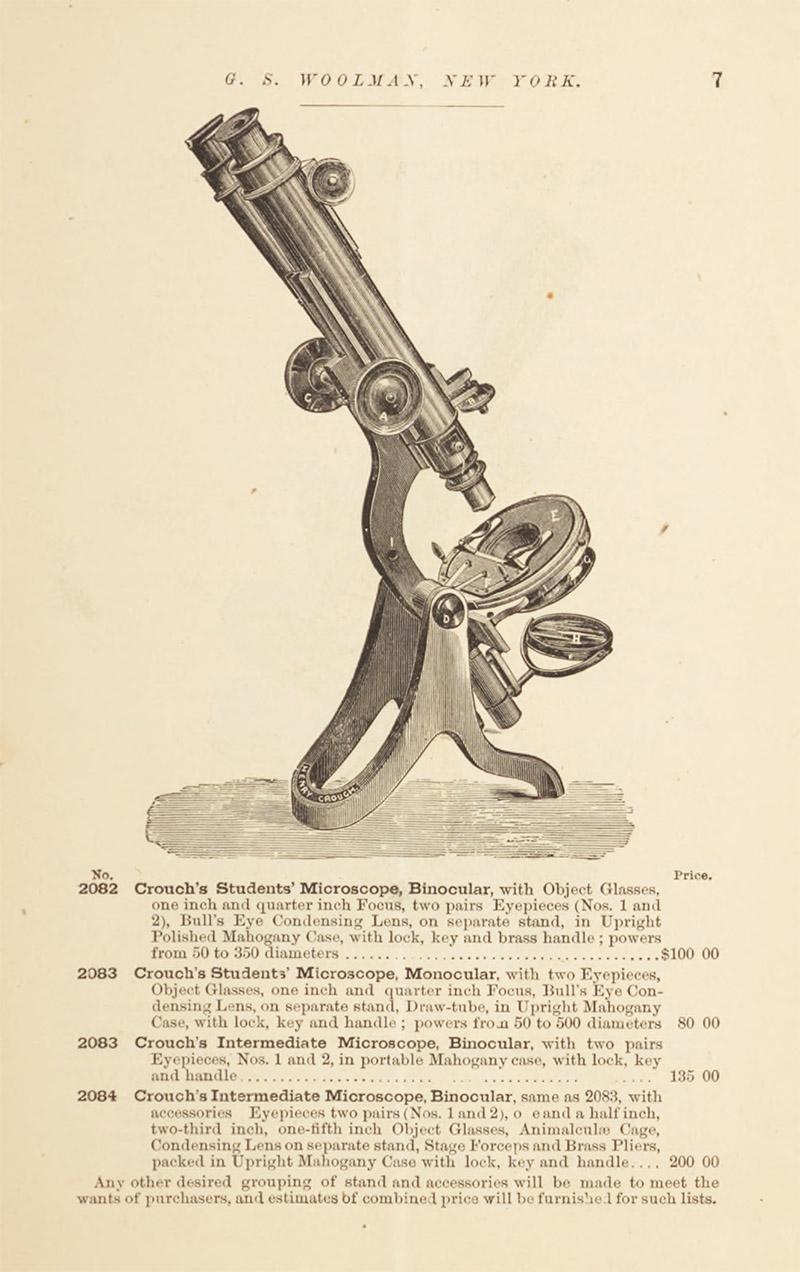
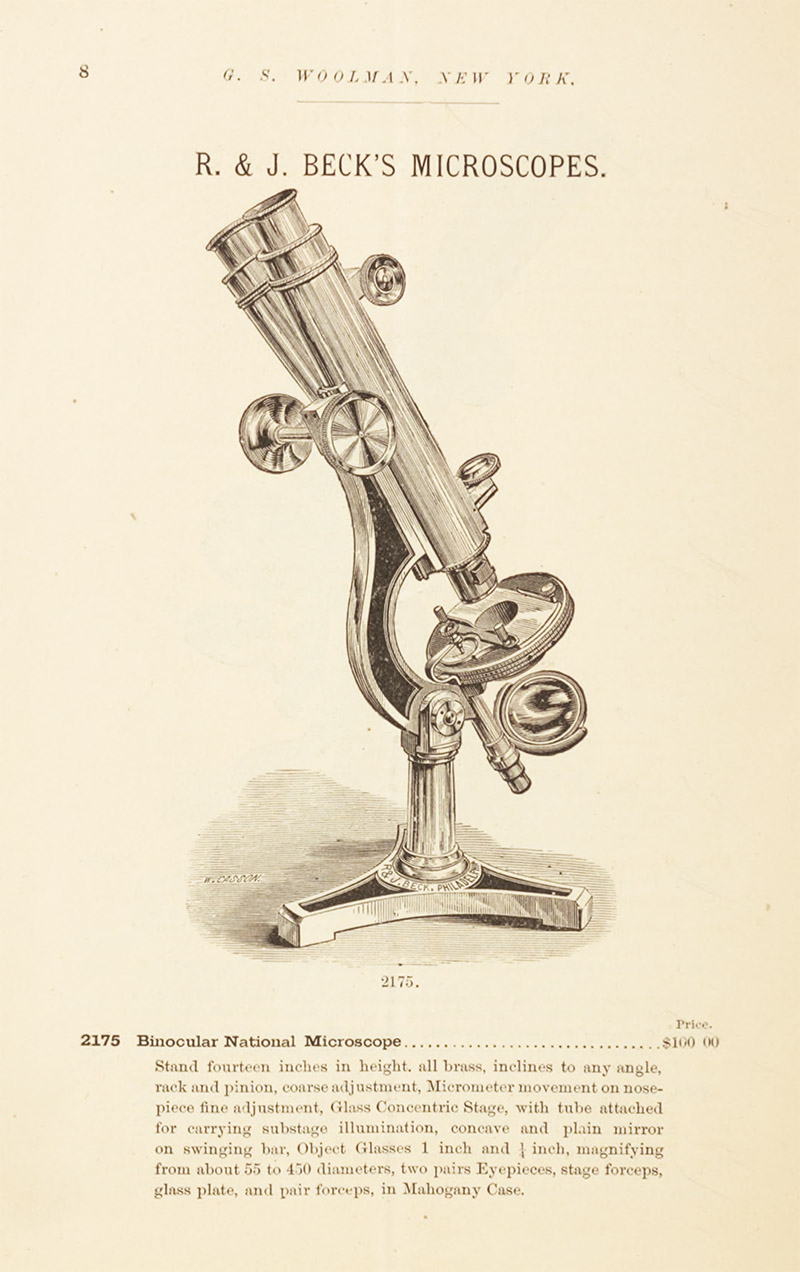
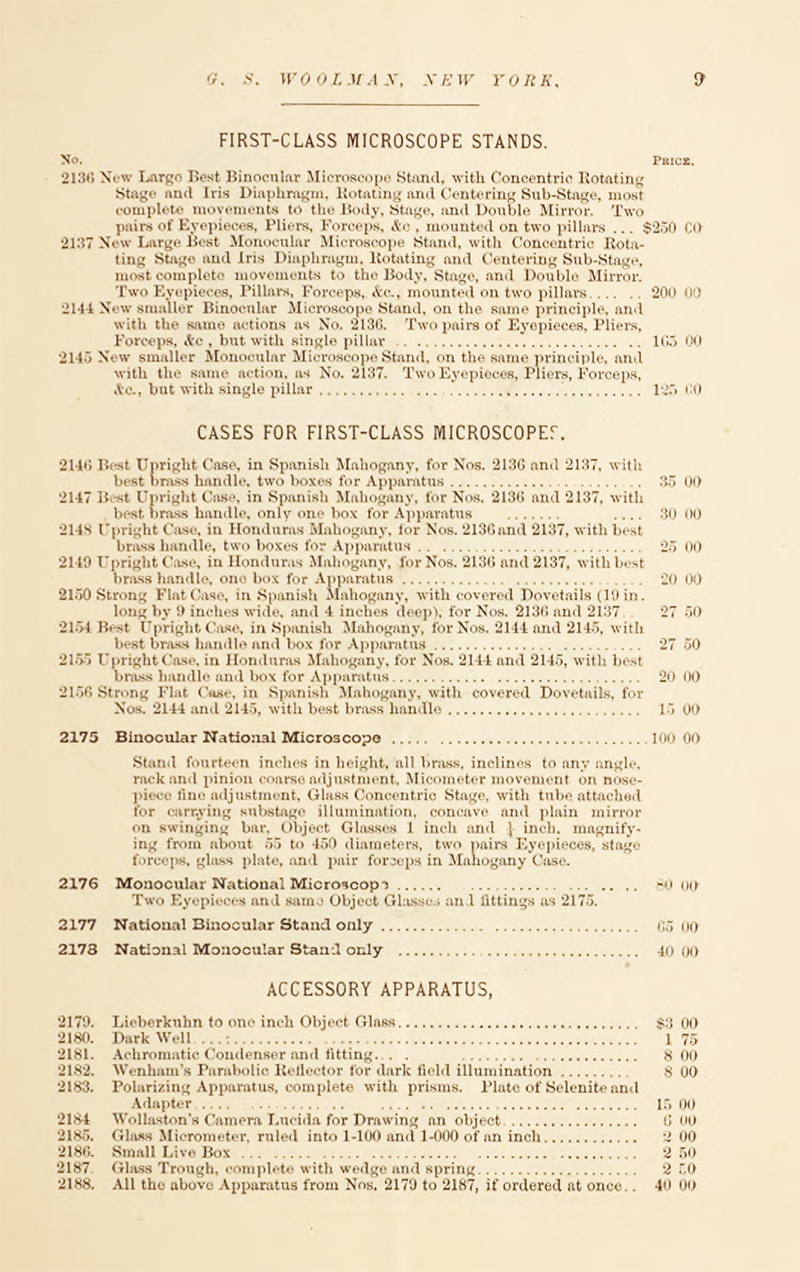
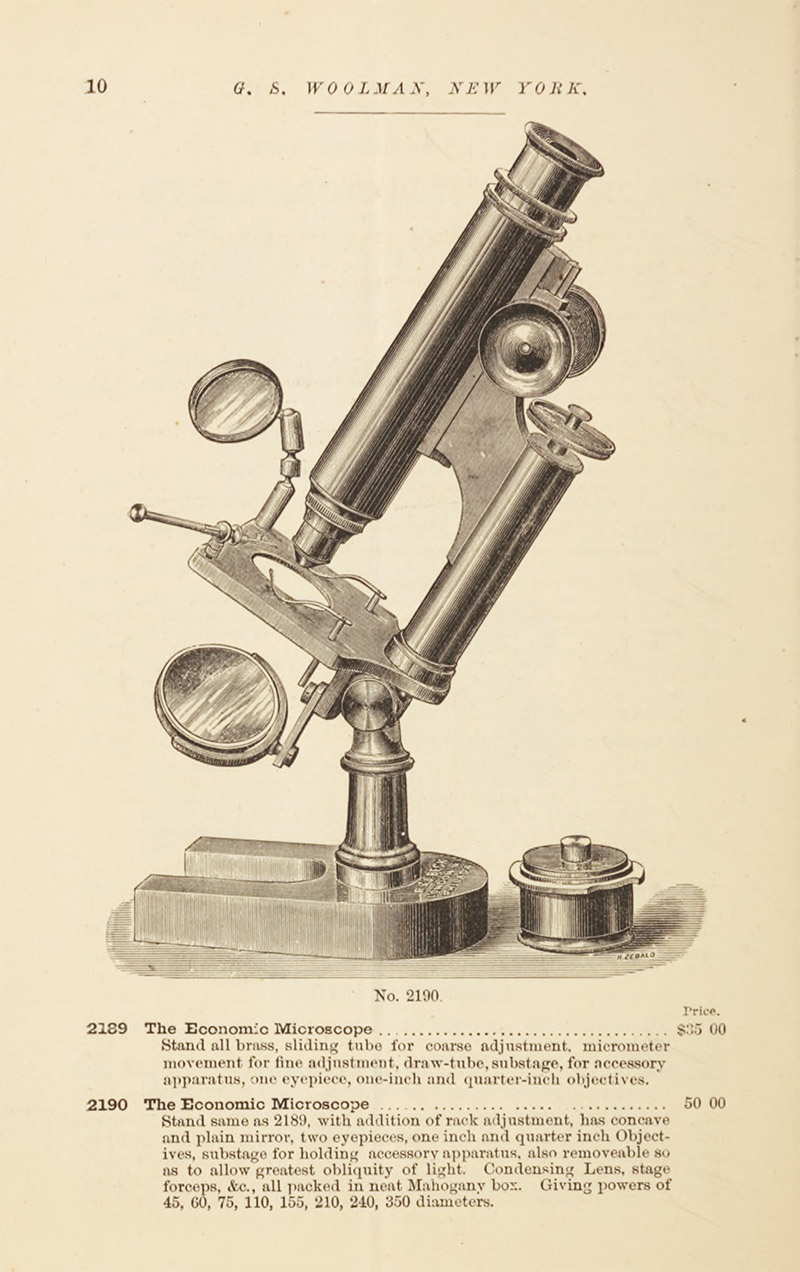
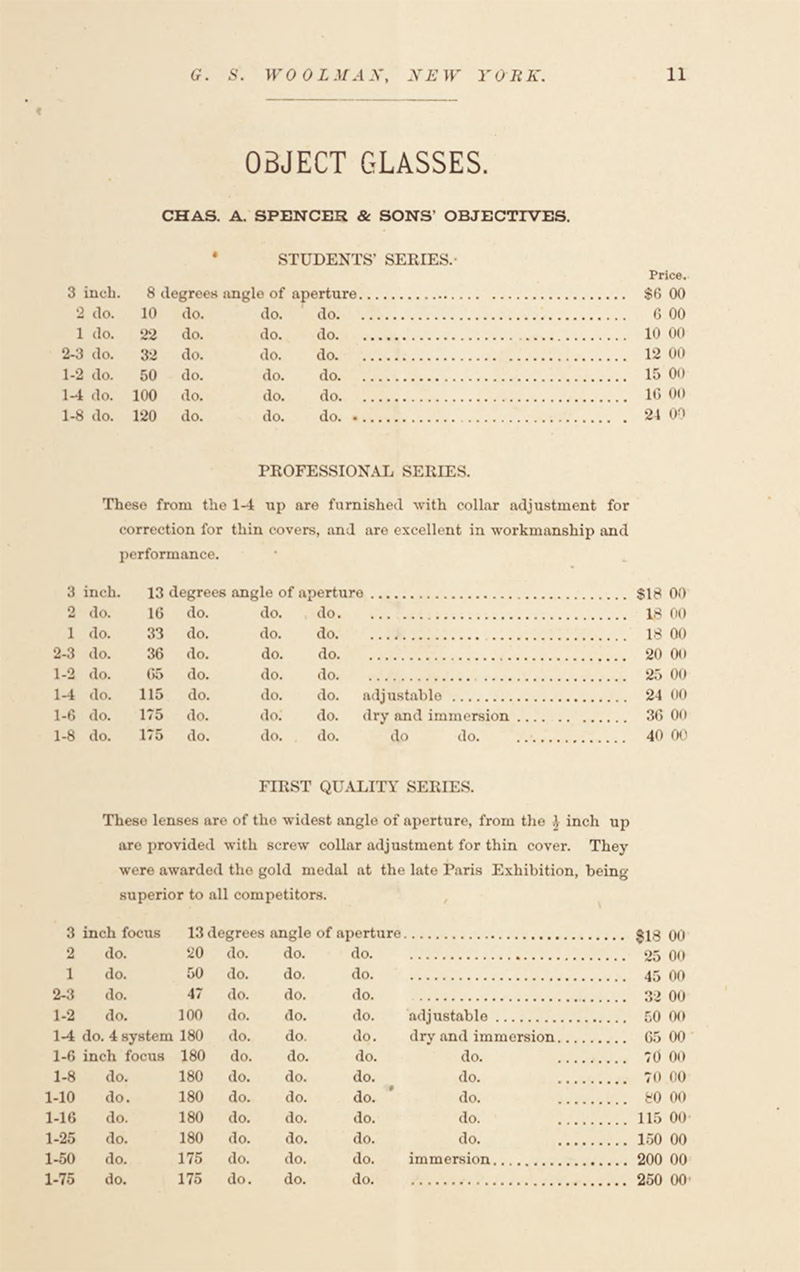

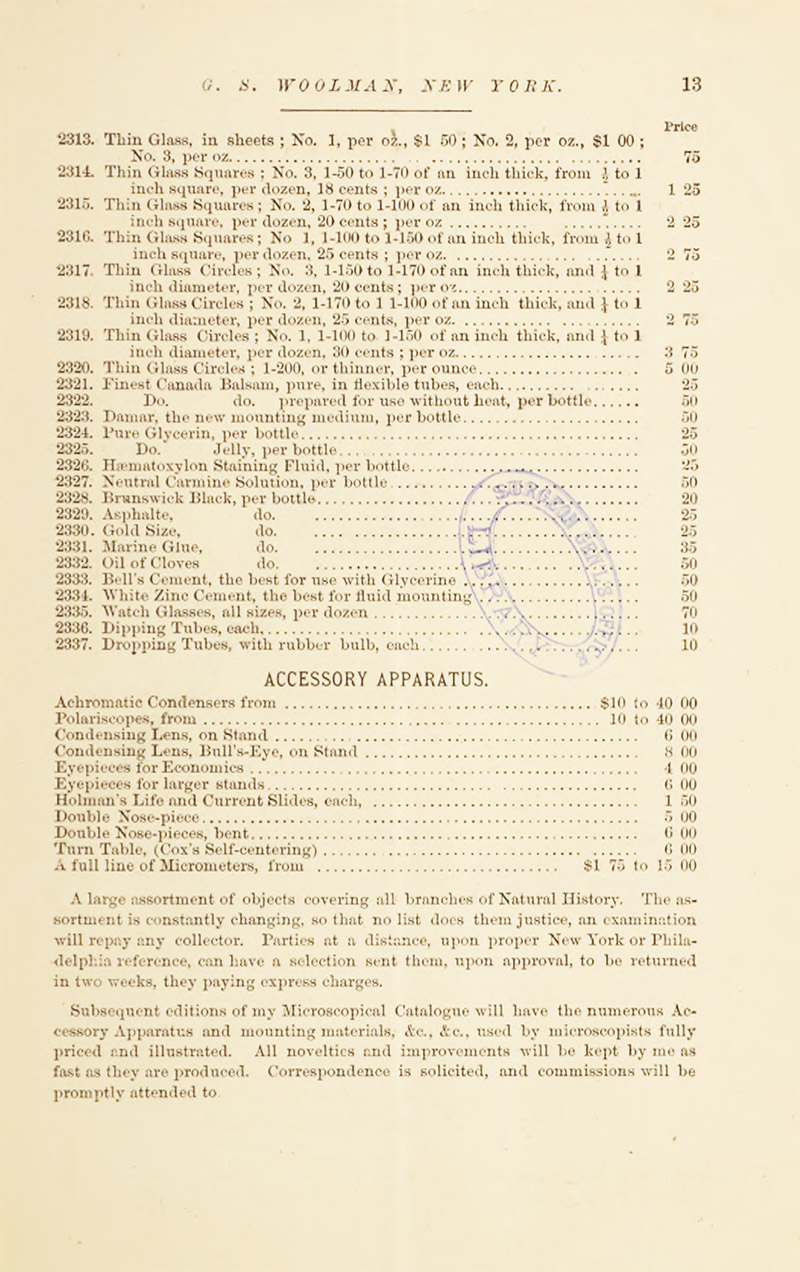
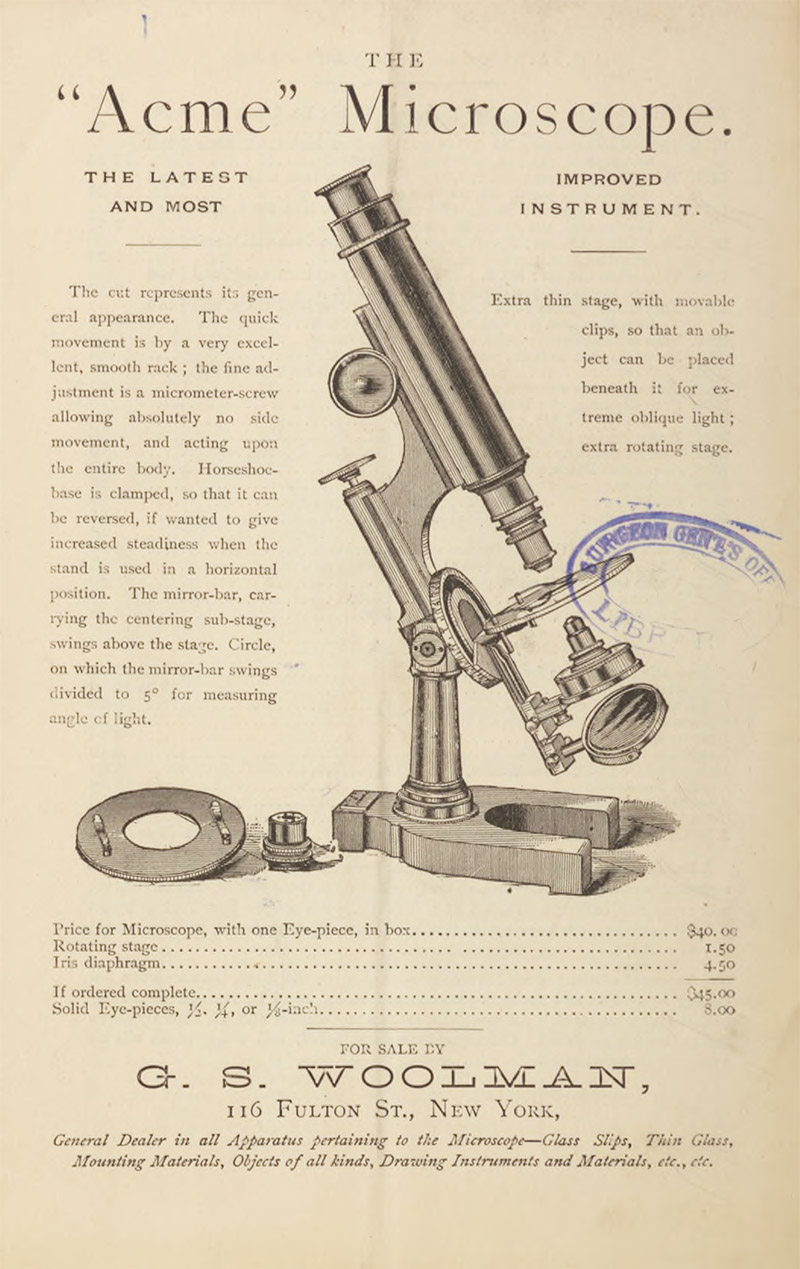
Figure 5.
G.S. Woolman's 1879 catalogue of microscopes, which illustrates many of his instruments. At the time, he was distributor for J.W. Queen & Co., Henry Crouch, R. & J. Beck, and "Acme" (Sidle and Poalk).
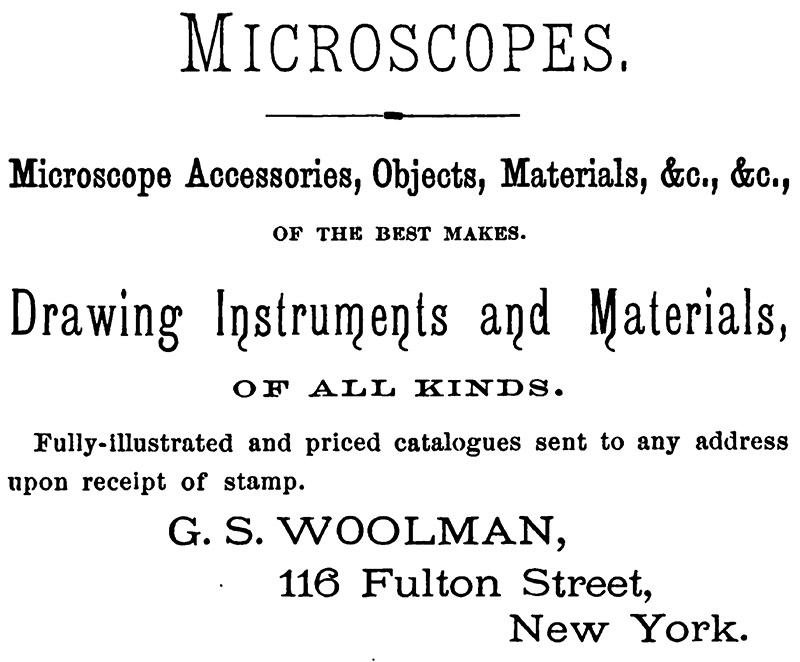
Figure 6.
An 1884 advertisement, from "The Naturalists' Directory".

Figure 7.
An 1886 advertisement, from "The Princeton Bric-a-brac".
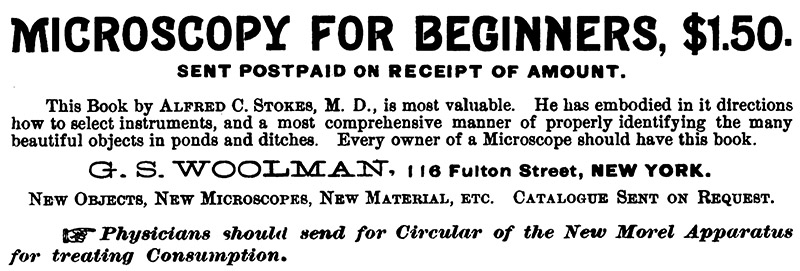
Figure 8.
An 1887 advertisement, from "The Microscope".
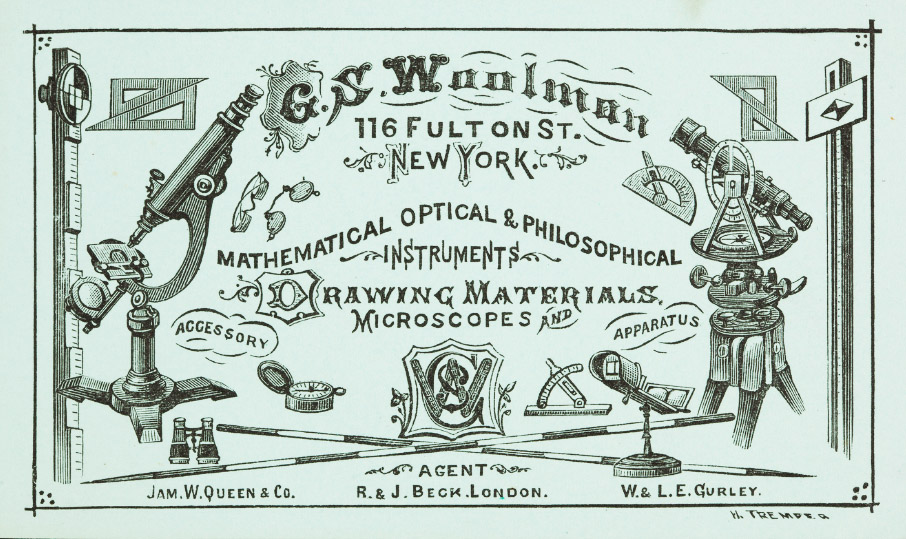
Figure 9.
An undated trade card from G.S. Woolman. He was described in the 1888 "Illustrated New York" as being an agent of J.W. Queen & Co., R. & J. Beck, and W. & L.E. Gurley. Adapted for nonprofit, educational purposes from https://www.historicnewengland.org/explore/collections-access/gusn/266837 .
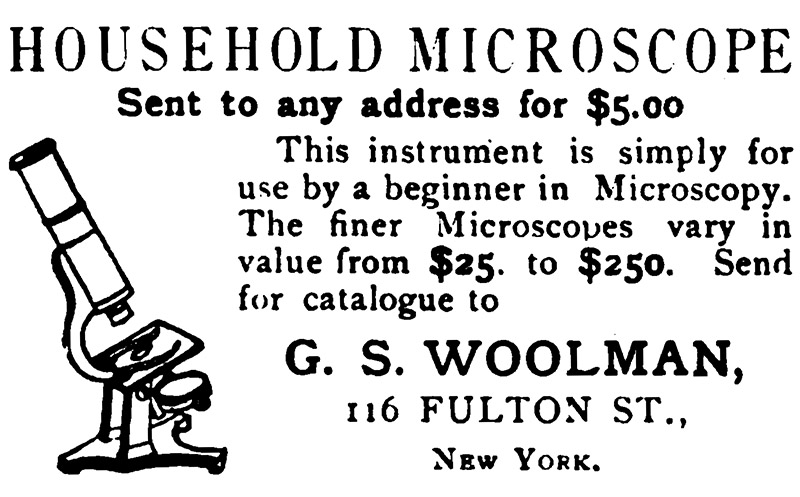
Figure 10.
An 1889 advertisement, from "Science". Note that Woolman featured two versions of Queen's "Household" microscope in his 1879 catalogue (see Figure 5, above).
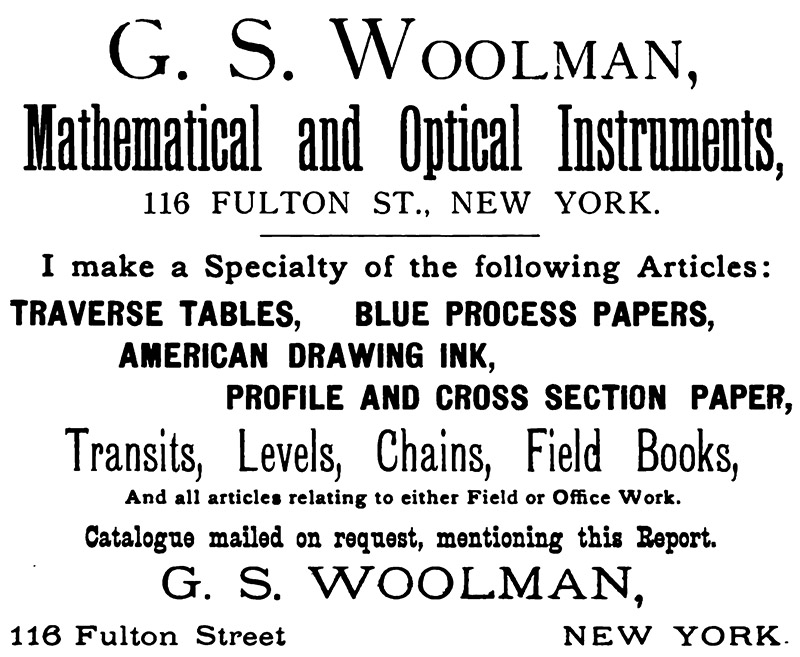
Figure 11.
An 1889 advertisement, from "Tenth Annual Report of the Ohio Society of Surveyors and Civil Engineers".
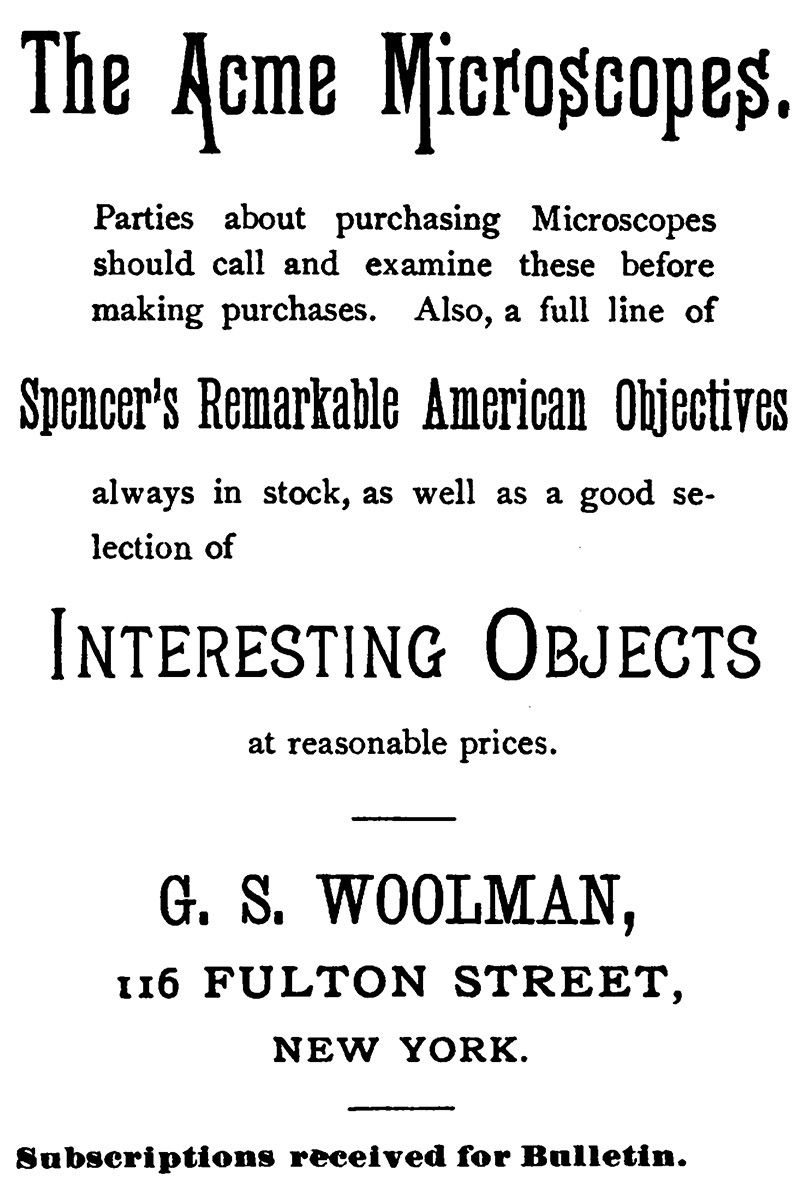
Figure 12.
An 1890 advertisement, from "The Microscopical Bulletin and Science News"
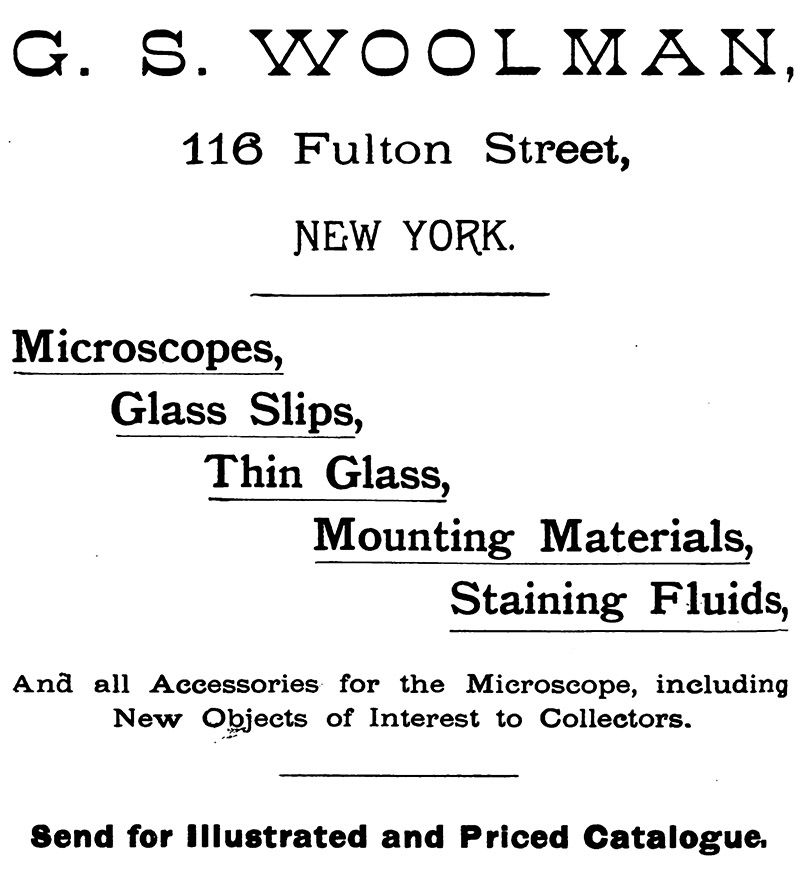
Figure 13.
An 1891 advertisement, from "The Journal of the New York Microscopical Society".

Figure 14.
An 1893 advertisement, from "The Microscope". Woolman was credited for introducing disposable paper lens wipes to the U.S.
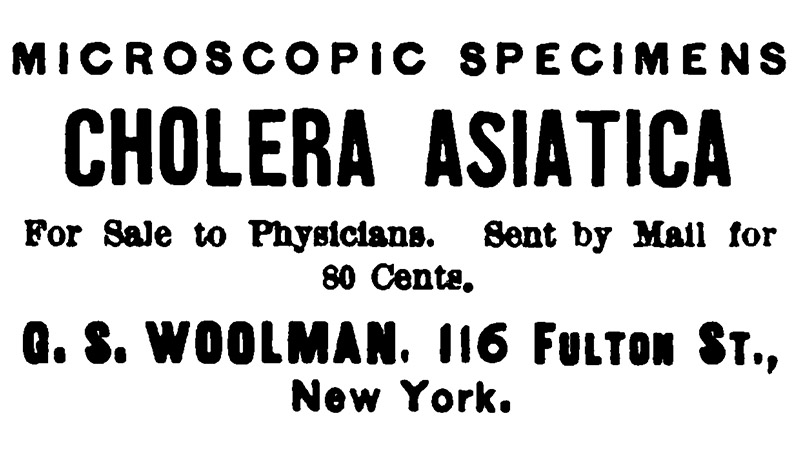
Figure 15.
An 1893 advertisement, from "The Medical Record".

Figure 16.
Woolman sold his business back to Queen in 1894, and remained with them as manager until 1898. Advertisement from "Colliery Engineer", 1894.
Resources
The American Bookseller (1876) "James W. Queen & Co., manufacturers of and dealers in optical instruments, have sold their New York business to George S. Woolman, for some years manager of the house. Mr. Woolman has removed the business from 601 Broadway to 116 Fulton street", Vol. 1, page 204
The American Monthly Microscopical Journal (1892) Paper for cleaning the lenses of objectives and oculars, pages 99-100
The American Naturalist (1876) "James W. Queen & Co. - This well-known firm has been once more dissolved, Mr. Cheyney carrying the department of philosophical apparatus with him to Bond Street, New York city. The remaining partners, S.L. Fox and W.H. Walmsley, retain the microscopical branch of the business at the old stand and under the old name. Microscopists will find G.S. Woolman in charge of their department at the New York store", Vol. 10, page 123
The American Stationer (1894) "G.S. Woolman, dealer in mathematical instruments, &c., 116 Fulton street, New York, has retired from business on his own account, and his establishment has been purchased by Queen & Co., Pa. Mr. Woolman is the New York manager for the company", Vol. 35, page 901
Colliery Engineer (1894) Advertisement from Queen & Co., Vol. 14, July issue
Engineering and Mining Journal (1894) "Queen & Co., Philadelphia, have purchased the stock and business of G. S. Woolman, dealer in mathematical instruments and engineers' supplies", Vol. 57, page 467
Engineering News (1898) "Queen & Co., Inc., Philadelphia and New York, announces that Mr. G.S. Woolman has ceased to be the manager of its office in the latter city", Vol. 39, Supplement page 16
Goulding´s New York City Directory (1876) "Woolman George S. optical insts, 116 Fulton, h 25 W 18th", page 1549
Illustrated New York: The Metropolis of To-Day (1888) G.S. Woolman, International Publishing Co., New York, page 153
Journal of the New York Microscopical Society (1891) Advertisement from G.S. Woolman
The Manufacturer and Builder (1894) Queen & Co., Vol. 26, page 166
The Naturalists' Directory (1884) S. Cassino, Boston, advertisement from G.S. Woolman in rear of book
New York City Directory (1871) "The following names have been received since the First Edition was issued …Woolman George S. math. insts. 535 B'way", first pages of directory
The Medical Record (1878) Advertisement from G.S. Woolman, Vol. 13, multiple issues
The Medical Record (1893) Advertisement from G.S. Woolman, Vol. 43, page 31
The Microscope (1887) Advertisements from G.S. Woolman
The Microscope (1893) Advertisements from G.S. Woolman
The Microscopical Bulletin and Science News (1890) Advertisements from G.S. Woolman
Philadelphia City Directory (1871) "Woolman George S., clerk, 924 Chestnut, h 3401 Bridge, W.P.", page 1519
The Princeton Bric-a-brac (1886) Advertisement from G.S. Woolman
Science (1889) Advertisements from G.S. Woolman, Vol. 14
Tenth Annual Report of the Ohio Society of Surveyors and Civil Engineers (1889) Advertisement from G.S. Woolman, page X
U.S. census and other resources, accessed through ancestry.com
Woolman, G.S. (1879) Priced and Illustrated Catalogue of Microscopes and Optical Instruments































